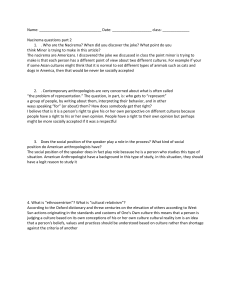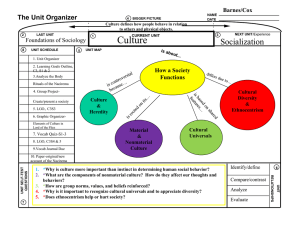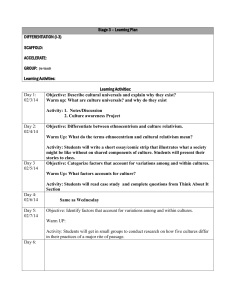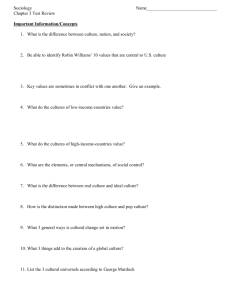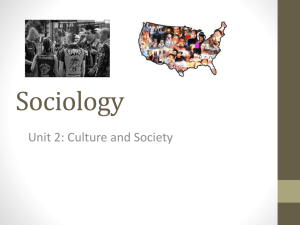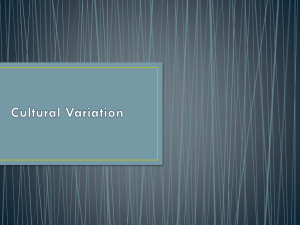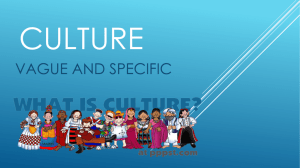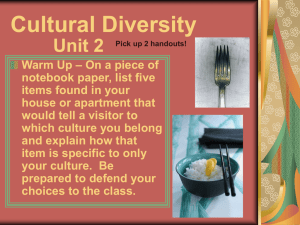Culture - Doral Academy Preparatory
advertisement
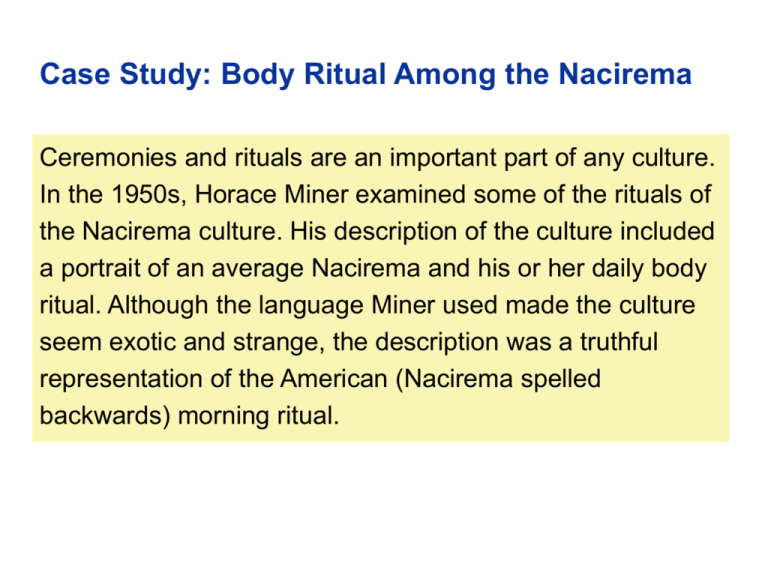
Case Study: Body Ritual Among the Nacirema Ceremonies and rituals are an important part of any culture. In the 1950s, Horace Miner examined some of the rituals of the Nacirema culture. His description of the culture included a portrait of an average Nacirema and his or her daily body ritual. Although the language Miner used made the culture seem exotic and strange, the description was a truthful representation of the American (Nacirema spelled backwards) morning ritual. What Is Culture? Culture consists of all the shared products of human groups, both physical and abstract. A society consists of the people who share a culture. Physical products Abstract products • Known as material culture • Includes automobiles, books, building, clothing, computers, and cooking utensils • Known as nonmaterial culture • Beliefs, family patterns, ideas, language, political and economic systems, rules, skills, and work practices Technology • Refers to objects and the rules for using them • Any tool and its usage • Any rule that makes a use of an object illegal The Components of Culture Symbols • The basis of human culture • Any words, gestures, or images that represent something else by association. • Different cultures use different symbols • Statue of Liberty as a symbol for opportunity, freedom, etc. Language • Organization of written or spoken symbols into a standardized system • Can be used to express any idea • Important to transmit culture The Components of Culture Values • Values are shared beliefs • Distinguish between good and bad, right and wrong, desirable and undesirable • Group’s values help to determine character and culture Norms • Shared rules of conduct in specific situations • Folkways do not carry heavy moral significance • Mores carry heavy moral significance • Laws are written and enforced by government Two Types of Norms • • • • Folkways Describe socially accepted behavior but do not have great moral significance Common customs of everyday life Failure to follow will result in reprimand or minor punishment Ex. Shake hands when introduced to someone • • • • Mores Great moral significance Violation of them endangers society’s stability Laws are usually created to protect society. For example, severe punishment for those who commit murder Ex. Do not kill another person What Do We All Have in Common? • Humans have ability to meet needs in a vast number of ways • Ability only limited by biological makeup and physical environment • Ability leads to great diversity in many ways Cultural Universals • Cultural universals are features developed by all societies to fulfill basic needs • George Murdock compiled list of over 65 cultural universals • Specific nature of the universals may vary widely between cultures The American Value System • Over the years, sociologists have identified what they believe are the core values of American society. • Among these values are work, individualism, morality and humanitarianism, personal achievement, and others. • American values have not stayed the same over time, however. New values, such as respect for the environment, regularly develop and become part of American culture. Other Core Values • Nationalism • Patriotism • Science and rationality • Education • Religion • Romantic love Our Changing Values While the United States has a set of core values, new values or changed values are sometimes noted. New Values Self-fulfillment and Narcissism • • • • • • • Some scholars see selffulfillment as a healthy new value, while others view its extreme, narcissism, as detrimental to society as a whole. Leisure Physical fitness Youthfulness Self-fulfillment Environmentalism Progress Cultural Variations Subculture Counterculture • Groups that share traits with each other but not the larger society • Countercultures adopt values that are designed to challenge the values of the larger society • Examples are groups organized by age, gender, politics, or geography • Most do not reject all of the values of the larger society • Most subcultures do not threaten the larger American culture • Examples are groups such as cyberpunks, anarchists, the Mafia, and hippies Response to Variation Ethnocentrism • A tendency to view one’s own culture and group as superior • People from all cultures are somewhat ethnocentric at different times • Can lead to discrimination • Can cause the home culture to stagnate • Even professional scholars struggle with ethnocentrism Xenocentrism • A tendency to view one’s own culture and group as inferior • Can create distress in a society. • Might be detrimental to a society’s growth. Response to Variation Cultural Relativism • Cultural relativism is the idea that a culture should be judged by its own standards, and not by the standards of another. Belief that all cultures are equal and should be appreciated for their differences. • Beliefs, customs and ethics are relative to the individual in a particular context. • Can help explain beliefs or behaviors that seem strange or different ETHNOCENTRISM CULTURAL RELATIVISM Cultural Change • Cultural diffusion • Cultural diffusion is the spreading of culture traits from one society to another • Occurs through different means: ex. Military conquest, tourism, mass media, missionary work, etc. • Today it can happen almost instantly • Innovation • Innovation is the process of introducing an idea or object new to a culture • 2 Forms of Innovation: discovery or invention Cultural Change • Cultural lag • Cultural lag is the time it takes for nonmaterial culture to “catch up” to changes in material culture • Nonmaterial changes slower than Material Culture. • Ex. Napster. The invention of the Internet (material culture); cultural lag took place because the rules of using the internet were not in place for a site like Napster. • Cultural leveling • Cultural leveling is a process by which cultures become more and more alike • Some suggest it is the first step toward a global culture • Ex. Globalization • McDonald’s and Starbucks in different parts of the world. Culture Shock • A feeling of confusion, doubt, or nervousness caused by being in a place that is very different from what you are used to.
